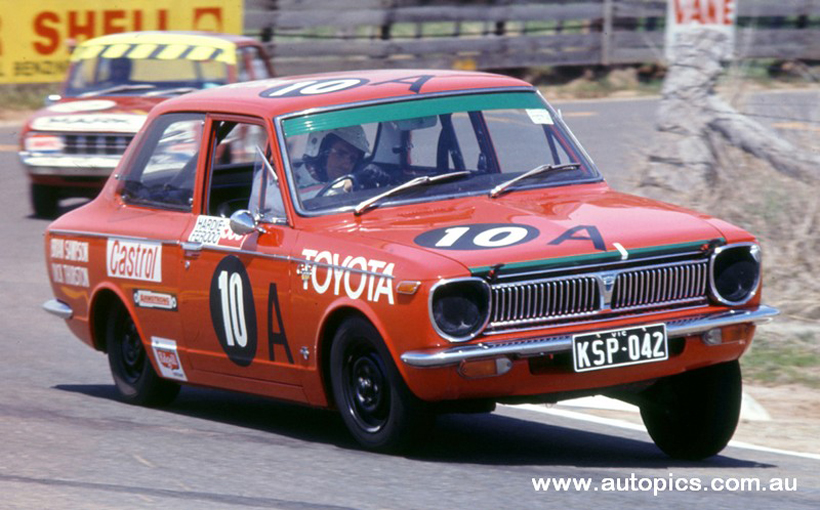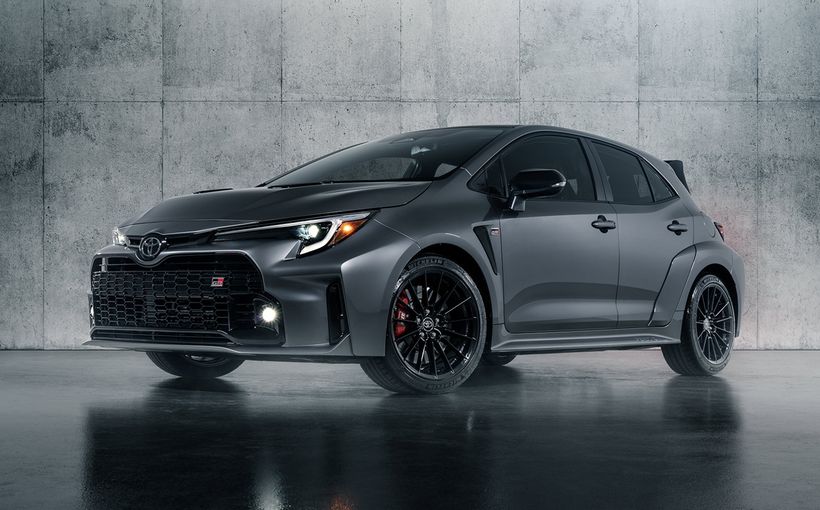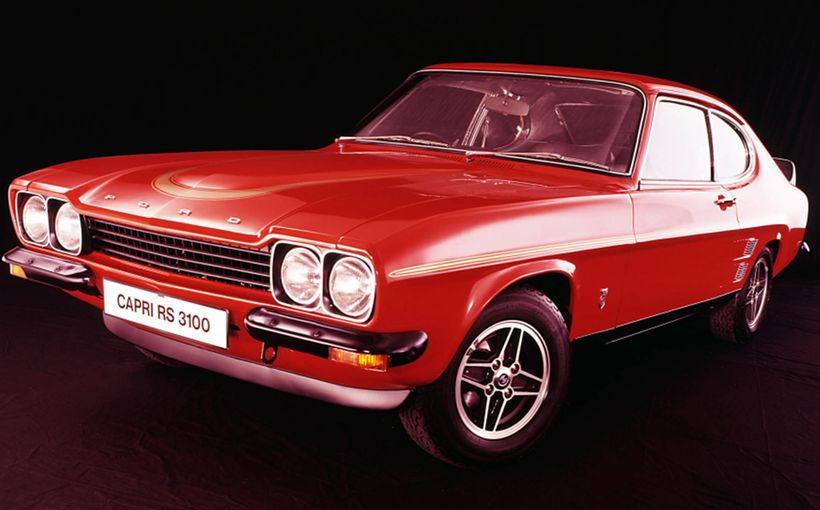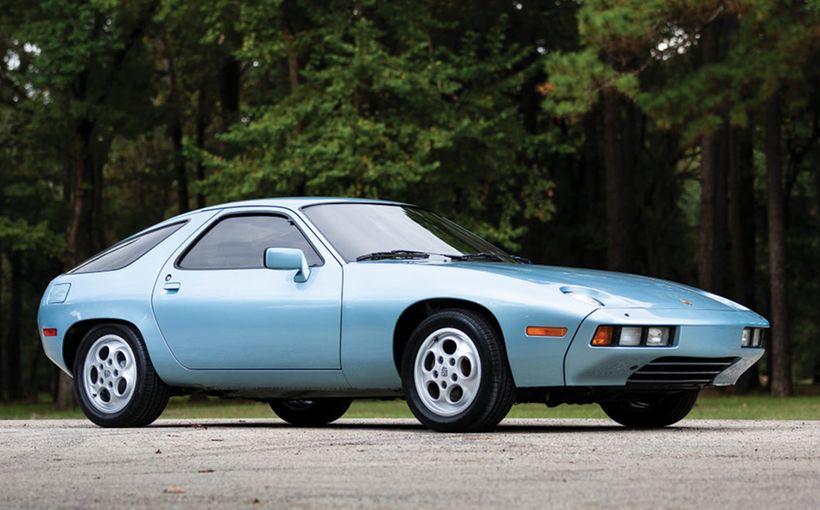Toyota KE10 Corolla: The little car that taught a champion how to win

“The Corollas were quite delicate to drive because they had very little horsepower,” said Bathurst and ATCC champion Bob Morris as he reflected on the locally assembled Japanese car that delivered him a class victory on debut at Bathurst in 1968 and a second win the following year.
“Because they didn’t have a lot of power, they were probably the best education you could get in terms of staying out of the way of faster cars. When you moved from one side of the road to the other it was like crossing the road, because there were often big Monaros and Falcon GTs coming through and their closing speeds were dramatic. So to stay out of everybody’s way yet still maintain a decent lap time you had to really concentrate, you were very busy.
“Driving those cars also taught me a lot about being smooth and maintaining momentum, which translated to every car I drove from then on. It was all about extracting the last little bit of power, getting it to the ground and keeping it all pointing in the right direction. I learned a lot of that from racing those Corollas, because you literally could not waste half a horsepower.”
Compared to the thundering V8 Toranas which Bob Morris drove to victory in the 1976 Bathurst 1000 and 1979 Australian Touring Car Championship, the first generation of Toyota’s universally popular small car would seem to be a most unlikely candidate for multiple Bathurst wins.

Released in Japan late in 1966, the KE10 Corolla soon followed in the tyre tracks of its Tiara and Corona predecessors with local production commencing in 1967 at Australian Motor Industries (AMI) in Port Melbourne.
Built on a short 90-inch (2286mm) wheelbase with a feather-like kerb weight of just over 700 kg, the stylish two-door sedan was powered by a very efficient 1.1 litre (1077cc) pushrod four cylinder engine rated at an excellent 60 bhp (44kW) with 61 ft/lbs (83Nm) of torque.
A sweet-shifting four-speed gearbox, leaf-sprung live rear axle, MacPherson strut/tranverse leaf front suspension and four wheel drum brakes completed a very conventional but durable package with a claimed top speed of 85 mph (136 km/h).
In comparison to the latest breed of Holden and Ford V8 muscle cars in the outright division, the Corolla was little more than a mobile chicane on a track as steep and fast as Mount Panorama. However, back in the days when Bathurst class wins were highly valued and fiercely contested, such comparisons were meaningless.

The KE10 Corolla was more than a match for its true nemesis – the Datsun 1000. The two burgeoning Japanese manufacturers were in a fight to win the hearts, mind and wallets of Aussie car buyers. And given the Bathurst 500’s proven influence on showroom sales, they threw everything they had at winning the small car class with well-drilled teams, exacting car preparation and gun drivers.
“The Toyota versus Datsun thing in Class A was a pretty fierce rivalry in those days,” Morris said. “You know, they (Datsun) had guys like Bill Evans and young Bevan Gibson (later killed in a sports car race at Bathurst) who were fast and very committed drivers. Normally the driving style in our team (AMI) was a bit conservative which we had to be to get the best performance from the Corollas, whereas the Datsun guys seemed to be able to throw their cars around a bit more.
“I never drove a Datsun 1000 but judging by the level of competition on the track, there was very little between them. I think it really came down to preparation, driving styles, pit stops and tactics. Each Bathurst race in those days could have gone either way."

1967 Gallaher 500
The new Toyota Corolla made its Bathurst debut the year before Bob Morris joined the AMI team. With the field broken up into several classes based on retail prices, the Corollas and Datsuns were at the rear of the field in Class A for cars costing up to $1800.
This promised to be a ferocious clash, with both brands fielding multi-car factory teams. AMI entered three KE10 Corollas with fast and experienced driver pairings that included Bruce Hindhaugh/Peter Macrow, Barry Ferguson/Brian Sampson and Bill Buckle/Dick Thurston. Datsun also entered works cars under the Datsun Racing Team banner, with John Roxburgh/Doug Whiteford and Japan’s Kunimitsu Takahashi/Hideo Oishi leading the charge.

However, there was a dark cloud of suspicion hanging over the legality of the leading cars as soon as they hit the track. Noted historian Bill Tuckey captured the mood in his seminal coverage of the 1967 race in Chevron’s Australia’s Greatest Motor Race:
“Class A practice proved in hindsight to be worthy of an Academy Award to most of the practice participants. The Whiteford/Roxburgh Datsun 1000 was fastest on 3 min 31.7 secs with the Takahashi/Oishi car on 3.32.8 and the three factory Corollas around the 3.34s, doubtless due to the fact in those days you had to take your car first to the scrutineers and then straight out on the track to practice – but you could work on it overnight and have an entirely different car for the race. In the race itself, the Corollas and Datsun 1000s somehow were six seconds a lap faster from the moment the flag fell.”
In what was arguably the greatest race within 'The Great Race', the works Corollas and Datsun slugged it out in an enthralling five-car dice which lasted for almost seven gruelling hours. The Ferguson/Sampson Corolla won from the Roxburgh/Whiteford Datsun, ahead of Thurston/Buckle (Corolla), Hindhaugh/Macrow (Corolla) and the Japanese pair (Datsun).

However, the AMI team’s celebrations were short-lived after post-race scrutineering revealed cylinder heads, manifolds and rear leaf springs which were ruled to be outside the showroom specifications. Such rulings would become disturbingly common in Class A in the years to come, as manufacturers bent the rules as far as they dared in trying to find even the tiniest winning advantage.
The three works Corollas which finished first, third and fourth were excluded, elevating the Roxburgh/Whiteford Datsun to the class win. However, after AMI lodged an appeal, the Buckle/Thurston Corolla was eventually cleared and reinstated as runner-up.

1968 Hardie-Ferodo 500
Bob Morris started motor racing in the mid-1960s, driving a Ford Cortina 220 as a teenager which his father Ray had raced in the 1965 Bathurst 500. Bob was competing in club races, circuit sprints and hill-climbs in the Cortina when a golden opportunity to drive a factory-backed Corolla at Bathurst presented itself through Toyota dealer Bill Buckle.
Sydney-based Ray Morris and Bill Buckle were friendly rivals, both on the race track and in local quality conversions of imported American cars from left-hand drive to right-hand drive. When Buckle became one of the first Toyota dealers in Australia, he was also recruited by the Japanese marque’s local assemblers AMI to drive Toyotas at Bathurst.
In 1968 Bob Morris bought a used KE10 Corolla from Buckle, which was one of the works cars that AMI had raced at Bathurst in 1967. After being upgraded to Improved Production specs, Morris showed prodigious speed in the car which made the then 19-year-old an ideal replacement for Buckle after he decided to hang up his helmet.

“They (AMI) were very professional for their time, running an in-house racing program and using all the staff from the factory as pit crew,” Morris said. “Bert Rydberg was running the team at the time and I thought he was a bit of an old fuddy-duddy. They flew me down to Calder for a test drive and then signed me up as one of their drivers.
“I almost didn’t get the drive though, simply because I asked Bert if they were going to put a roll bar in the car for Bathurst as I was always conscious of safety. However, Bert thought from that question that I might have been frightened of going to Bathurst! Anyway, it all worked out and my first drive there was as a factory driver in a factory team.”
The 1968 race was looking like a re-run of the previous year’s knock-em-down, drag-em-out fight for the Class A crown between Toyota and Datsun. AMI again sought safety in numbers by entering three KE10 Corollas with different driver pairings that comprised Bob Morris/Bruce Hindhaugh, Dick Thurston/Brian ‘Brique’ Reed and 1967 provisional winners Barry Ferguson/Brian Sampson. There was also a privately-entered Corolla for Jim Laing-Peach/Bob Drane.

The top Datsun 1000 crews this year were Bill Evans/John Colwell and Ray Sorenson/Bevan Gibson. After Toyota’s disqualification in 1967 and the Datsun Racing Team’s strong showing in the inaugural Datsun Three-Hour race at Sandown a few weeks prior to the 1968 race, the AMI Toyota team was hungry for revenge.
Sampson led the three other Corollas early in the race while the Evans/Colwell Datsun pitted with ignition problems. Drane’s Corolla got into the lead but broke a front hub at Forrest’s Elbow, forcing him to park it and run back to the pits for a replacement. Ferguson was then forced to surrender the lead to his team-mates Morris and Hindhaugh, after his Corolla’s oil filter worked loose. From there the two works Corollas were fast and flawless. By mid-afternoon they had lapped the factory Datsuns and that’s the way they finished; the Toyota pair one lap clear of the Datsun duo. And it was to get worse for Datsun, after their cars were excluded at post-race scrutineering for some illegal tampering of the carburettors.
Revenge exacted, the AMI team ecstatic. And the fact that its teenage recruit Bob Morris had taken a Bathurst class victory at his first attempt did not go unnoticed by those who needed to know…

1969 Hardie-Ferodo 500
The Bathurst Class A scorecard was now one apiece for Toyota and Datsun. Their relentless battles in 1967 and 1968, in which the cars had been driven virtually flat-out for seven hours in Australia’s toughest motor race, had brought credibility and buyer loyalty to both brands.
With both models selling up a storm in Aussie showrooms, the stakes had never been higher than in 1969 when the KE10 Corolla and Datsun 1000 clashed for the third and final time in Class A.
AMI trimmed its usual three-pronged attack back to two works cars for Bob Morris/Brian Sampson and Barry Ferguson/Jim Laing-Peach, backed by another privately entered car for Chris Cronan/Steve Parks. Datsun matched AMI with two works Datsun 1000s for Bill Evans/Barry Tapsall and 1966 Bathurst winner Bob Holden with Don Toffolon.

However, Datsun’s two-car attack was halved after Toffolon wrote-off his car in the Dipper during practice and the Sampson/Morris Corolla took pole position. The slighter larger capacity Toyotas were claimed to be almost 4 mph (6.5 km/h) faster on Conrod Straight than the Datsuns, with top speeds through the radar trap exceeding 100 mph (160 km/h). Morris recalled that a noticeable performance gain that year was the introduction of proper racing tyres, with better gearing (lower profile) and grip (softer compounds) compared to road tyres of the past.
Fortunately the Class A cars managed to avoid the multi-car pile-up triggered by the infamous first lap crash at Skyline that year, as they were running at the tail of the field.
“When I arrived there everyone had stopped,” Morris recalled. “John French in his Alfa was sitting upside down in the middle of the road and I was talking to him through his window to make sure he was alright. I naively thought the race would be stopped when they started to wave us through (the wreckage). So I cruised back to the pits at a leisurely pace, only to see the pit guys there frantically waving me on and making it very clear that the race was continuing!”

In another classic Datsun vs Toyota stoush which lasted more than six and a half hours, the factory Toyota attack was also halved after the Ferguson/Laing-Peach Corolla became stranded in the pits with a jammed starter motor. Its replacement, which took 30 minutes, got the car back in the race but also meant exclusion from the results.
That left the Class A fight to the Sampson/Morris Corolla and Evans/Tapsall Datsun, with the lead Toyota continuing to display an advantage in top speeds down Conrod and building up a two-lap winning advantage by the time the chequered flag fell.
It was another outstanding result for Toyota and the AMI team, particularly for ‘the kid’ Bob Morris who now had two Bathurst class wins from two starts.

1970 Hardie-Ferodo 500
Not surprisingly, renowned talent spotter Harry Firth - who had formed the new Holden Dealer Team in 1969 - offered Bob Morris a drive in one of his new LC Torana GTR XU-1s at Bathurst the following year, alongside another new recruit called Peter Brock. Although their Torana would finish many laps down due to engine trouble, Morris’s career (like Brock’s) was clearly in the ascendant.
Morris’s departure required another reshuffle of AMI’s driving talent for the 1970 Bathurst clash, as the Toyota team also upgraded to the more powerful 1166cc version of the KE10 Corolla commonly referred to as the ‘Corolla 1200’ in racing circles.

This capacity upgrade, introduced in September the previous year, was timely as the intensity of the Class A war also shifted up a gear in 1970 with the Bathurst debut of new Datsun 1200 Mazda 1300 and Ford Escort 1300 rivals. The reigning champs knew they had a real fight on their hands.
Toyota returned to a three-car factory attack in 1970 with regional AMI dealer Max Stewart making his first appearance in a Corolla (he drove a Corona 1900 the previous year) teamed with Dick Young. The other works cars were crewed by Brian Sampson/Dick Thurston and Bill Evans/Garry Cooke, along with a private entry for Bill Stanley and motoring journalist Mike Kable.

Unlike the previous year’s two-lap towelling, the more powerful Corolla 1200s were outgunned in qualifying by the new Datsun 1200s and Mazda 1300s. And despite the depth of AMI’s driver line-up the Corollas were also outclassed in the race, with a Datsun 1200 and two Mazda 1300s claiming the three top spots. Next were Sampson and Thurston in the highest-placed Corolla - a lap behind the winning Datsun.
It was the fourth and last time the AMI team’s KE10 Corollas would compete in the Bathurst 500, as the second generation KE20 model had by then entered production. With two class wins, a second and a fourth place from four Bathurst starts, the Corolla proved what a tough and capable performer it really was. By then of course Australia’s love affair with the Corolla was already well established; a relationship which decades on shows no sign of decline.
Protect your Corolla. Call Shannons Insurance on 13 46 46 to get a quote today.









